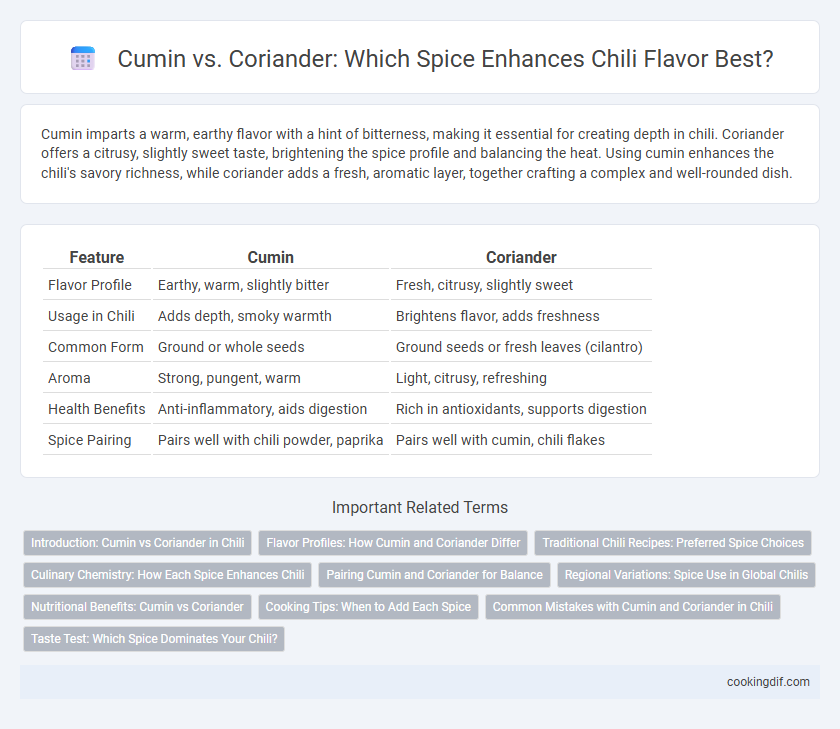Cumin imparts a warm, earthy flavor with a hint of bitterness, making it essential for creating depth in chili. Coriander offers a citrusy, slightly sweet taste, brightening the spice profile and balancing the heat. Using cumin enhances the chili's savory richness, while coriander adds a fresh, aromatic layer, together crafting a complex and well-rounded dish.
Table of Comparison
| Feature | Cumin | Coriander |
|---|---|---|
| Flavor Profile | Earthy, warm, slightly bitter | Fresh, citrusy, slightly sweet |
| Usage in Chili | Adds depth, smoky warmth | Brightens flavor, adds freshness |
| Common Form | Ground or whole seeds | Ground seeds or fresh leaves (cilantro) |
| Aroma | Strong, pungent, warm | Light, citrusy, refreshing |
| Health Benefits | Anti-inflammatory, aids digestion | Rich in antioxidants, supports digestion |
| Spice Pairing | Pairs well with chili powder, paprika | Pairs well with cumin, chili flakes |
Introduction: Cumin vs Coriander in Chili
Cumin and coriander are essential spices in chili, each contributing distinct flavors that define the dish's character. Cumin offers a warm, earthy, and slightly smoky aroma, enhancing the chili's depth and richness. Coriander adds a citrusy, slightly sweet note that balances the heat and complements the robust spices in chili recipes.
Flavor Profiles: How Cumin and Coriander Differ
Cumin features a warm, earthy flavor with a slightly bitter undertone that intensifies the smoky, spicy notes of chili dishes. Coriander offers a citrusy, sweet, and slightly floral profile that brightens and balances the heat in chili recipes. Using cumin emphasizes depth and warmth, while coriander introduces freshness and complexity to the spice blend.
Traditional Chili Recipes: Preferred Spice Choices
Traditional chili recipes emphasize cumin for its warm, earthy aroma that enhances the dish's depth and complexity. Coriander is used less frequently but adds a subtle citrus undertone that balances the rich flavors of tomatoes and chilies. Cumin's bold, smoky notes remain the preferred spice for achieving authentic, robust chili flavor profiles.
Culinary Chemistry: How Each Spice Enhances Chili
Cumin contributes a warm, earthy bitterness to chili, enhancing its depth by stimulating bitter taste receptors and complementing smoky ingredients like chipotle. Coriander seeds provide a citrusy, slightly sweet aroma with volatile oils such as linalool that brighten and balance the chili's robust flavors. The interaction between cumin's intense umami qualities and coriander's fresh undertones creates a complex flavor profile that elevates the chili's overall sensory experience.
Pairing Cumin and Coriander for Balance
Cumin and coriander create a harmonious balance in chili by combining cumin's warm, earthy bitterness with coriander's bright, citrusy undertones. This spice pairing enhances the chili's complex flavor profile, delivering depth without overpowering the dish. Blending ground cumin and coriander seeds ensures a well-rounded and aromatic chili that highlights both spices' complementary qualities.
Regional Variations: Spice Use in Global Chilis
Cumin enhances chili with a warm, earthy flavor, predominantly favored in Mexican and Tex-Mex regional recipes for its robust aroma and slight bitterness that complements smoky chilies. Coriander offers a brighter, citrusy profile often utilized in Indian and Southeast Asian chilies, balancing heat with a fresh, slightly sweet undertone. Regional variations reflect local agricultural availability and cultural taste preferences, resulting in diverse spice blends where cumin or coriander may dominate to define the chili's unique flavor identity.
Nutritional Benefits: Cumin vs Coriander
Cumin contains significant amounts of iron, manganese, and dietary fiber, aiding digestion and boosting immunity. Coriander is rich in antioxidants, vitamin C, and magnesium, promoting heart health and reducing inflammation. Both spices offer distinct nutritional benefits that complement chili dishes by enhancing flavor and health properties.
Cooking Tips: When to Add Each Spice
Cumin should be added early in the cooking process to release its earthy, warm flavors, especially during the sauteing of onions and garlic in chili recipes. Coriander, with its citrusy and slightly sweet notes, works best when added later in cooking or as a finishing touch to preserve its bright aroma. Proper timing of these spices enhances the depth and complexity of chili, balancing heat and flavor profiles effectively.
Common Mistakes with Cumin and Coriander in Chili
A common mistake in chili preparation is confusing cumin and coriander, despite their distinct flavor profiles; cumin offers a warm, earthy depth while coriander provides a lemony brightness. Overusing cumin can overpower the dish, leading to a bitter taste, whereas excessive coriander may dilute the chili's robust spiciness. Understanding their unique roles enhances the harmonious balance essential for authentic chili seasoning.
Taste Test: Which Spice Dominates Your Chili?
Cumin imparts a warm, earthy flavor with a slightly smoky undertone, making it a classic choice for chili seasoning, while coriander offers a citrusy, floral brightness that can lighten the dish's richness. In taste tests, cumin often dominates the chili's flavor profile by enhancing depth and warmth, whereas coriander provides a subtle, refreshing contrast without overpowering other spices. Balancing these spices depends on desired chili complexity; cumin emphasizes boldness, and coriander adds nuanced brightness.
Cumin vs Coriander for spice emphasis Infographic

 cookingdif.com
cookingdif.com